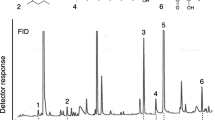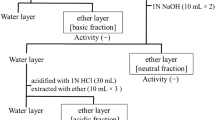Abstract
The trail pheromone of the antTetramorium caespitum L. is a 70∶30 mixture of 2,5-dimethylpyrazine and 3-ethyl-2, 5-dimethylpyrazine. The average total amount of the two pyrazines present in the poison vesicle was found to be 3.9 ng per ant, of which 2.7 ± 0.4 ng is 2,5-dimethylpyrazine and 1.15 ±0.25 ng is 3-ethyl-2,5-dimethylpyrazine. The pyrazines constitute only 0.03% of the volume of the poison vesicle but account for the whole of the trail-following activity. A 70∶30 mixture of the respective pyrazines evoked the highest activity in artificial trail-following tests.
Similar content being viewed by others
References
Attygalle, A.B., andMorgan, E.D. 1983. Trail pheromone of the antTetramoriumcaespitum L.Naturwissenschaften 70:364–365.
Baker, R., Bradshaw, J.W.S., Evans, D.A., Higgs, M.D., andWadhams, L.J. 1916. An efficient all-glass splitter and trapping system for gas chromatography.J. Chromatogr. Sci. 14:425–427.
Baker, R., Herbert, R.H., andLomer, R.A. 1982. Chemical components of the rectal gland secretions of maleDacus cucurbitae the melon fly.Experientia 39:232–233.
Barlin, G.B. 1982. The Pyrazines: Chemistry of Heterocyclic Compounds, Vol. 41. Interscience, New York.
Blum, M.S. 1974. Pheromonal sociality in the Hymenoptera, pp. 222–249,in M. C. Birch (ed.). Pheromones. Elsevier, Amsterdam.
Blum, M.S., andRoss, G.N. 1965. Chemical releasers of social behavior. V. Source, specificity, and properties of the odour trail pheromone ofTetramorium guineense (F.) (Formicidae: Myrmicinae).J. Insect Physiol. 11:857–868.
Bolton, B. 1976. The ant tribe Tetramoriini (Hymenoptera: Formicidae).Bull. Br. Mus. Nat. Hist. (Entomol.) 34:283–378.
Brophy, J.J., andCavill, G.W.K. 1980. Naturally occurring pyrazines and their mass spectrometric characterisation.Heterocycles 14:477–504.
Buttery, R.G., Guadagni, D.G., andLing, L.C. 1973. Volatile components of baked potatoes.J. Sci. Food Agric. 24:1125–1131.
Cavill, G.W.K., Robertson, P.L., andDavies, N.W. 1979. An argentine ant aggregation factor.Experientia 35:989–990.
Cross, J.H., Byler, R.C., Ravid, U., Silverstein, R.M., Robinson, S.W., Baker, P.M., De Oliveira, J.S., Jutsum, A.R., andCherrett, J.M. 1979. The major component of the trail pheromone of the leaf-cutting ant.Attasexdens rubropilosa Forel.J. Chem. Ecol. 5:187–203.
Deck, R.E., andChang, S.S. 1965. Identification of 2,5-dimethylpyrazine in the volatile flavour compounds of potato chips.Chem. Ind. pp. 343–1344.
Evershed, R.P., Morgan, E.D., andCammaerts, M.C. 1981. Identification of the trail pheromone of the antMyrmica rubra L., and related species.Naturwissenschaften 67:374–375.
Evershed, R.P., Morgan, E.D., andCammaerts, M.C. 1982. 3-Ethyl-2,5-dimethylpyrazine, the trail pheromone from the venom gland of eight species ofMyrmica ants.Insect Biochem. 12:383–391.
Evershed, R.P., andMorgan, E.D. 1983. The amounts of trail pheromone substances in the venom of workers of four species of Attine ants.Insect Biochem. 13:469–474.
Goldman, I.M., Seibl, J., Flament, I., Gautschi, F., Winter, M., Willhalm, B., andStoll, M. 1967. Recherches sur l'arome de café, II Pyrazines et pyridines.Helv. Chim. Acta 50:694–705.
Hayashi, N., andKomae, H. 1977. The trail and alarm pheromones of the ant,Pristomyrmex pungens Mayr.Experientia 33:424–425.
Huwyler, S., Grob, K., andViscontini, M. 1975. The trail pheromone of the antLasius fuliginosus: Identification of six components.J. Insect Physiol. 21:299–304.
Maga, J.A., andSizer, C.E. 1973a. Pyrazines in foods. Review.J. Agric. Food. Chem. 21:22–30.
Maga, J.A., andSizer, C.E. 1973b. Pyrazines in foods.Crit. Rev. Food Technol. 4:39–45.
Morgan, E.D.,andWadhams, L.J. 1972. Gas chromatography of volatile compounds in small samples of biological materials.J. Chromatogr. Sci. 10:528–529.
Morgan, E.D. 1984. Chemical words and phrases in the language of pheromones for foraging and recruitment,in T. Lewis (ed.). Insect Communication. Academic Press, London, In press.
Pasteels, J.M., andVerhaeghe, J.C. 1974. Dosage biologique de la phéromone de piste chez les fourrageures et les reines deMyrmica rubra.Insectes Soc. 21:167–180.
Riley, R.G., Silverstein, R.M., Carroll, B., andCarroll, R. 1974. Methyl 4-methylpyrrole-2-carboxylate, a volatile trail pheromone from the leaf cutting antAtta cephalotes.J. Insect Physiol. 20:651–654.
Ritter, F.J., Bruogemann-Rotgans, I.E.M., Verwiel, P.E.J., Persoons, C.J., andTalman, E. 1977. Trail pheromone of the pharaoh's antMonomorium pharaonis; isolation and identification of faranal. A terpenoid related to juvenile hormone II.Tetrahedron Lett. 30:2617–2618.
Robinson, S.W., Moser, J.C., Blum, M.S., andAmante, E. 1974. Laboratory investigations of the trail-following responses of four species of leaf-cutting ants with notes on the specificity of a trail pheromone ofAtta texana (Buckley).Insectes Soc. 21:87–94.
Stenhagen, E., Abrahamson, S., andMcLafferty, F.W. 1974. Registry of Mass Spectral Data. Wiley-Interscience, London.
Tumlinson, J.H., Moser, J.C., Silverstein, R.M., Brownlee, R.G., andRuth, J.M. 1972. A volatile trail pheromone of the leaf-cutting ant,Atta texana.J. Insect Physiol. 18:809–814.
Vander Meer, R.K., Williams, F.D., andLofgren, C.S. 1981. Hydrocarbon components of the trail pheromone of the red imported fire ant,Solenopsis invicta.Tetrahedron Lett. 00:1651–1654.
Van Vorhis Key, S.E., andBaker, T.C. 1982. Trail-following responses of the argentine ant,Iridomyrmex humilis (Mayr), to a synthetic trail pheromone component and analogs.J. Chem. Ecol. 8:3–14.
Wheeler, J.W., Avery, J., Olubajo, O., Shamin, M.T., Storm, C.B., andDuffield, R.M. 1982. Alkylpyrazines from Hymenoptera, isolation, identification and synthesis of 5-methyl-3-n-propyl-2-(1-butenyl) pyrazine fromAphaenogaster ants (Formicidae).Tetrahedron 38:1939–1948.
Williams, H.J., Strand, M.R., andVinson, S.B. 1981. Trail pheromone of the red imported fire antSolenopsis invicta (Buren).Experientia 37:1159–1160.
Author information
Authors and Affiliations
Rights and permissions
About this article
Cite this article
Attygalle, A.B., Morgan, E.D. Identification of trail pheromone of the antTetramorium caespitum L. (Hymenoptera: Myrmicinae). J Chem Ecol 10, 1453–1468 (1984). https://doi.org/10.1007/BF00990315
Received:
Revised:
Issue Date:
DOI: https://doi.org/10.1007/BF00990315




